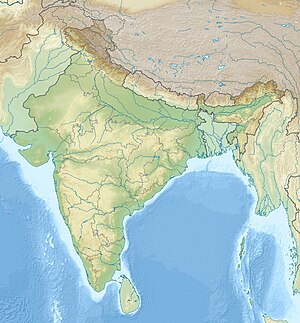Yavanarajya inscription
|
The Yavanarajya inscription, dated to "year 116 of Yavana hegemony", probably 70 or 69 BCE, was discovered in Mathura. Mathura Museum.
|
|
| Material | red sandstone |
|---|---|
| Period/culture | 1st Century BCE |
| Discovered | 27°36′00″N 77°39′00″E |
| Place | Mathura, India. |
| Present location | Mathura Museum, India |
The Yavanarajya inscription, also called the Maghera inscription, was discovered in Mathura, India in 1988. The inscription, carved on a block of red sandstone, is dated to the 1st century BCE, and is currently located at the Mathura Museum in Mathura. The inscription was published and analysed by French indologist Gérard Fussman in 1993. The inscription is important in that the Mathura sculptors mention the date of their dedication as "The last day of year 116 of Yavana hegemony (Yavanarajya)". It is considered that this inscription is attesting the control of the Indo-Greeks in the 2nd and 1st centuries BCE in Mathura, a fact that is also confirmed by numismatic and literary evidence.
The Yavanarajya inscription describes a dedication for a well and a tank in Mathura on "The last day of year 116 of Yavana hegemony (Yavanarajya)". It is considered that this inscription is attesting the control of the Indo-Greeks in the 2nd and 1st centuries BCE in Mathura, a fact that is also confirmed by numismatic and literary evidence.
Although the term Yavanas, meaning "Greek" (from the region of "Ionia") was used more broadly in the following centuries to designate various foreigners, in the 2nd and 1st centuries BCE the term "Yavana" does quite securely designate Indo-Greeks, rather than Indo-Parthians (called Palhavas) or Indo-Scythians (called Sakas) who were less relevant in India in that early time period. Also, these other groups are never mentionned by the term Yavanas in later inscriptions in Mathura.
The year 116 probably refers to the Yavana era (yonana vasae) thought to begin in 186-185 BCE. The inscription referring to the 116th year of the Yavana era (starting in 186-185 BCE) would thus have a date of 70 or 69 BCE.
The Yavanarajya inscription, written in elegant Sanskrit reads:
...
Wikipedia

